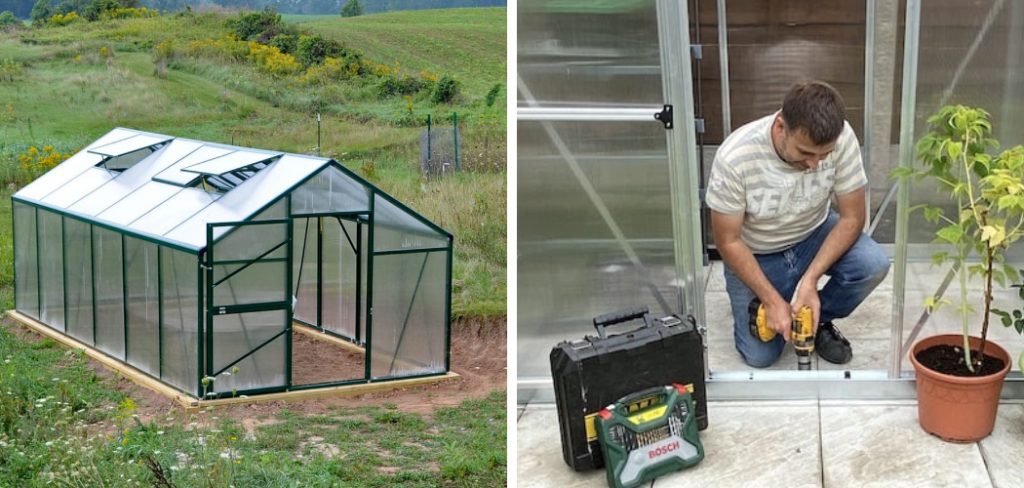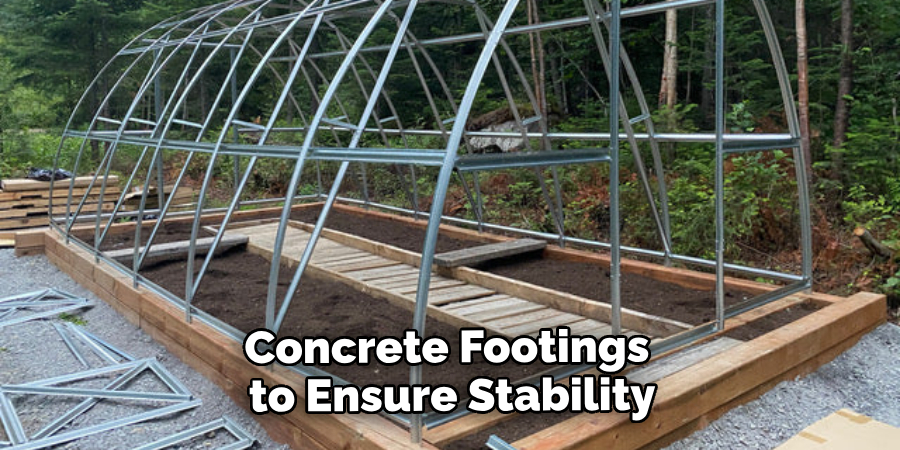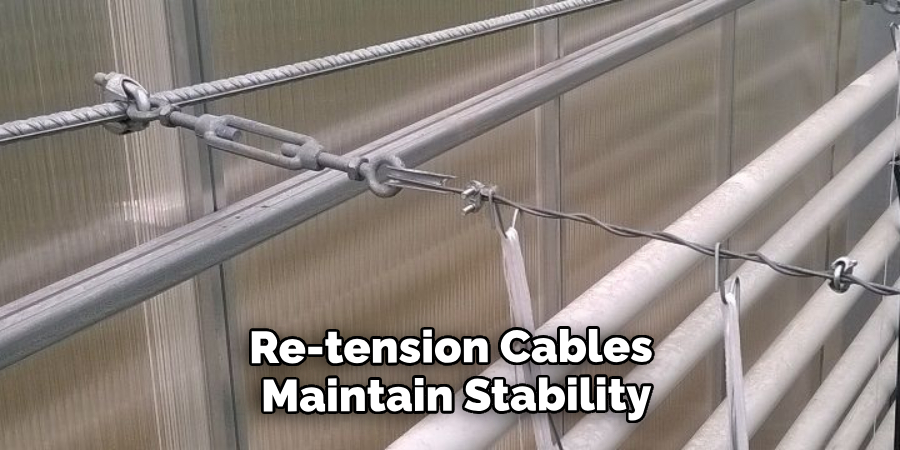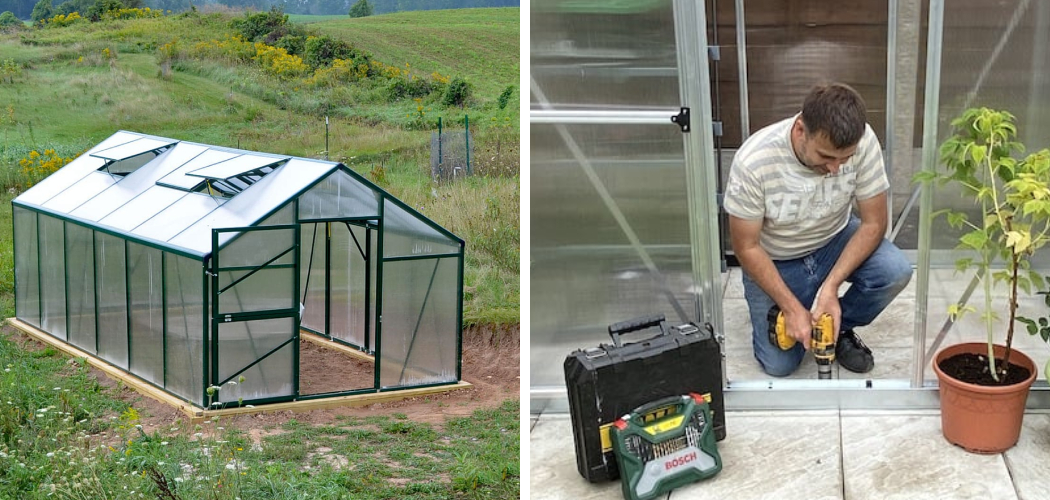To anchor a small greenhouse, start by selecting a suitable location and clearing the area. Then, use ground anchors, such as screw-type anchors or stakes, to secure the greenhouse framework firmly into the ground.

Factors To Consider
Factors to consider when anchoring a small greenhouse include climate and weather conditions, the size and type of greenhouse, soil type, budget constraints, and ease of installation. By taking into account the specific climate and weather patterns in your area, you can determine the necessary anchors and supports to withstand wind, rain, and other elements.
The size and type of greenhouse also play a role, as larger structures may require more robust anchoring systems. Understanding the soil type is crucial, as it affects the stability and security of the anchors. Budget constraints should be considered to find affordable but effective anchor options.
Lastly, evaluating the ease of installation helps ensure a proper and efficient setup. By considering these factors, you can anchor your small greenhouse effectively and provide a stable environment for your plants.
How to Anchor a Small Greenhouse: Step by Step Guide
Ground Anchors
Anchor your small greenhouse securely using various ground anchors like auger anchors, duckbill anchors, screw anchors, and mobile home anchors. These anchors provide stability by firmly securing the structure to the ground. Auger anchors are spiral-shaped and driven into the ground using a drill, while duckbill anchors use tension to anchor the greenhouse.
Screw anchors are twisted into the ground and are ideal for softer soil types. Mobile home anchors are specifically designed for anchoring lightweight structures like greenhouses. By using these different types of anchors, you can ensure that your small greenhouse remains stable even in harsh weather conditions.
So, when considering how to anchor your small greenhouse, explore the options presented by these ground anchors for a secure and sturdy structure.
Concrete Footings
Concrete footings are essential when it comes to anchoring a small greenhouse securely. They provide stability and support to the structure, preventing any shifting or movement. By using concrete footings, you ensure that your greenhouse remains in place even during strong winds or heavy rains.
The process of creating concrete footings involves several steps. First, you need to determine the size and layout of the footings according to the dimensions of your greenhouse. Next, gather the necessary materials, including cement, sand, gravel, and reinforcement bars.
Dig holes in the ground according to your planned layout and pour the concrete mixture into the holes. Use a level to ensure that the footings are even and allow them to cure for at least 48 hours before proceeding with the greenhouse installation.
Following these steps will help you create sturdy and durable concrete footings for your small greenhouse.
Earthbags
Looking for a reliable method to anchor your small greenhouse? Consider using earthbags as an effective solution. These bags, filled with a mixture of soil and sand, provide stability to your greenhouse structure. Not only are earthbags easy to use, but they also offer numerous benefits.
Firstly, they are cost-effective since soil and sand are easily accessible. Additionally, earthbags provide excellent resistance against strong winds, ensuring the safety of your greenhouse. To anchor your greenhouse using earthbags, follow these simple steps: start by selecting a suitable location for your greenhouse.
Then, prepare the earthbags by filling them with the soil and sand mixture. After that, place the bags strategically around the greenhouse perimeter, ensuring they are evenly spaced. Finally, firmly tamp down the bags to secure them in place. By following these steps, you can effectively anchor your small greenhouse using earthbags.
Preparing The Ground
Preparing the ground for anchoring a small greenhouse involves several important steps. Begin by clearing any vegetation and debris from the designated area. Next, make sure the ground is level by removing any uneven spots or obstructions. Once the ground is level, determine the anchor points for the greenhouse.
These points should be evenly spaced and strategically placed for optimum stability. Lastly, mark the exact placement for the anchors to ensure accurate installation. By following these steps, you will create a solid foundation for your small greenhouse, providing stability and protection for your plants.
Anchoring The Greenhouse
To anchor a small greenhouse, the first step is to install ground anchors securely. Next, pour concrete footings to ensure stability and support. After that, fill earthbags and tamp them down firmly to provide additional anchoring strength. These steps are crucial in preventing the greenhouse from being blown away or damaged during severe weather conditions.

By following this step-by-step guide, you can ensure the safety and longevity of your small greenhouse. Anchoring the greenhouse is essential for protecting your plants and investment, so take the time to complete each step carefully and accurately. By doing so, you can enjoy a sturdy and reliable structure that will withstand the test of time and weather.
Securing The Greenhouse
Securing a small greenhouse involves attaching the frame to anchors, using bracing and support systems. By properly tensioning and stabilizing the structure, you can ensure its durability and functionality. Begin by selecting suitable anchors and positioning them securely in the ground.
Attach the greenhouse frame to the anchors using strong and reliable fasteners. Install bracing components, such as corner braces or cross bars, to provide additional support and strength. Regularly check and adjust the tension in the greenhouse structure to counteract any movements or shifts caused by external factors.
This will help maintain stability and prevent damage. By following these steps, you can effectively anchor your small greenhouse and create a secure and stable environment for your plants.
Regular Inspections
Regular inspections are crucial for ensuring the stability of a small greenhouse. By regularly checking the anchors and connections, you can identify any potential weak points that may jeopardize the overall structure. Monitoring soil erosion is also a vital step in maintaining the stability of the greenhouse.
By keeping an eye on the erosion of soil around the anchors, you can take timely actions to address any issues. It is important to identify and address weak points promptly to prevent any damage or collapse. Regular inspections and monitoring will help you ensure the longevity and safety of your small greenhouse.
Remember to be thorough and diligent in your inspections to avoid any potential problems in the future. Stay proactive in maintaining the stability of your small greenhouse.
Seasonal Adjustments
To ensure your small greenhouse stays anchored throughout changing seasons, make seasonal adjustments. Re-tension cables and straps periodically to maintain stability. This will help counter the effects of temperature variations and wind gusts. Additionally, consider reinforcing the greenhouse structure by adding extra pegs or stakes to secure it firmly to the ground.

This prevents any potential damage caused by strong winds or heavy snowfall. By adapting your anchoring system based on the weather conditions, you can ensure the longevity and durability of your small greenhouse. Taking these precautionary measures will help protect your plants, allowing them to thrive in a safe and stable environment.
Anchoring your greenhouse properly is essential for maintaining its integrity and safeguarding your investment.
Frequently Asked Questions On How To Anchor A Small Greenhouse
How Do You Anchor A Small Greenhouse To The Ground?
To anchor a small greenhouse, start by choosing suitable anchors such as ground screws or stakes. Dig holes for the anchors and ensure they are securely placed in the ground. Attach the greenhouse base or frame to the anchors using proper fasteners.
Regularly check and tighten the anchors as needed to maintain stability.
Why Is It Necessary To Anchor A Small Greenhouse?
Anchoring a small greenhouse is crucial to prevent it from getting damaged or blown away by strong winds or extreme weather conditions. Anchoring provides stability and ensures that the greenhouse remains intact, protecting your plants and investments.
What Are The Best Types Of Greenhouse Anchors?
The best types of greenhouse anchors are ground screws, which are driven directly into the ground and provide excellent stability. Alternatively, heavy-duty stakes or auger-style anchors can also be used. Choose anchors that are suitable for your specific soil type and the size of your greenhouse for maximum effectiveness.
Conclusion
To ensure your small greenhouse remains secure and protected, anchoring is a crucial step. By following the right techniques and using sturdy materials, you can safeguard your greenhouse against strong winds, heavy rain, and other potential threats. Firstly, consider the type of anchoring system that suits your greenhouse’s location and size.
From screw anchors to concrete footers, there are various options available. Research the local weather conditions and soil type before finalizing your choice. Additionally, ensure that you choose the right tools and materials for installation. By properly securing the frame and anchor points, you can prevent damage and extend the lifespan of your greenhouse.
Regularly inspect and maintain the anchoring system to ensure its integrity. With a well-anchored greenhouse, you can enjoy the benefits of extended growing seasons and a protected environment for your plants. So don’t delay, anchor your small greenhouse today!

